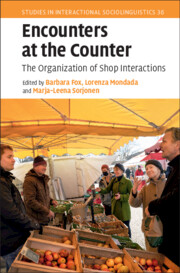Book contents
- Encounters at the Counter
- Studies in Interactional Sociolinguistics
- Encounters at the Counter
- Copyright page
- Contents
- Contributors
- 1 Encounters at the Counter
- 2 Approaching the Counter at the Supermarket
- 3 Customers’ Inquiries about Products
- 4 Offering a Taste in Gourmet Food Shops
- 5 Embodied Trajectories of Actions in Shop Encounters
- 6 Unpacking Packing
- 7 The Request-Return Sequence
- 8 Moving Money
- Appendix Transcription Conventions
- Index
- References
8 - Moving Money
Money as an Interactional Resource in Kiosk Encounters in Finland
Published online by Cambridge University Press: 19 January 2023
- Encounters at the Counter
- Studies in Interactional Sociolinguistics
- Encounters at the Counter
- Copyright page
- Contents
- Contributors
- 1 Encounters at the Counter
- 2 Approaching the Counter at the Supermarket
- 3 Customers’ Inquiries about Products
- 4 Offering a Taste in Gourmet Food Shops
- 5 Embodied Trajectories of Actions in Shop Encounters
- 6 Unpacking Packing
- 7 The Request-Return Sequence
- 8 Moving Money
- Appendix Transcription Conventions
- Index
- References
Summary
A shop encounter is normatively closed when payment is made. This paper analyzes the ways in which the physical presence of money (whether as cash, or bank card) shapes the payment phase of the interaction at kiosks in Finland. This study demonstrates that customers orient to payment from the very beginning of the interaction and work to prepare their money and to make it observable to the seller from early on. Moreover, if the customer has made their money observable prior to the price announcement by the seller, the payment phase moves quickly and smoothly to completion. If, on the other hand, the money has not been made observable early in the interaction, payment can be delayed. Conversely, customers can put their money on the seller’s side of the counter before payment has been made relevant; in such cases, the seller adjusts his or her actions to speed up the interaction so that the payment phase arrives earlier than is typical. Thus, through money, especially displays of it early in the interaction, customers show their orientation to progressivity.
Information
- Type
- Chapter
- Information
- Encounters at the CounterThe Organization of Shop Interactions, pp. 255 - 278Publisher: Cambridge University PressPrint publication year: 2023
References
Accessibility standard: Unknown
Why this information is here
This section outlines the accessibility features of this content - including support for screen readers, full keyboard navigation and high-contrast display options. This may not be relevant for you.Accessibility Information
- 1
- Cited by
